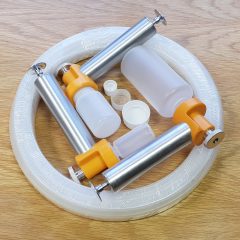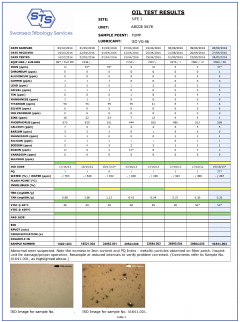New Customers
New Customers
Welcome
You have taken the first step on your journey to improved reliability and reduced maintenance spend.
 If you just want to get started please have a look at our quick start guide here.
If you just want to get started please have a look at our quick start guide here.
Otherwise you can start by reading brief introductions on Condition Based Maintenance and Oil Analysis in particular.
And here you can learn about OAS and STS, our philosophy and how we approach what we do.
You can also explore our Services section which is arranged by testing category and business sector. Just click on Services in the main menu to choose a relevant item.
You can learn about the layout of our reports and get a quick overview of OASDB – our web results database.
You can also explore our knowledge base, where you can learn more about dealing with us, taking and shipping of samples, interpretation of oil analysis results and some of the actions you may be able to take in response to specific issues. It is a work in progress and will hopefully grow as time goes by. Click on Knowledge Base in the main menu of the site.
You can also download our Brochure from the downloads section.
Whatever you do, don’t forget to get in touch – drop us a line or give us a call and we will be happy to discuss how we can help.
You can even try the service for free via our new customer virgin oil analysis offer.
Why Call us?
Our service is aimed at clients with every possible level of understanding of oil analysis – from novices to seasoned experts. We have created this site to give some key introductory information and a flavour of what we offer as well as somewhere you can brush up a little on the subject in your own time, but to make sure we understand your needs and how best to meet them a dialogue works best.
How you reach out is up to you – you can use the contact form, email us or simply pick up the phone. We would then work with you to understand your situation and the best way to meet your needs. Our objective is to give you a perfectly tailored service which will have you coming back time and time again.
Your first order, setting up an account and basic payment terms
Getting started with us is simple. Often our first contact with a new customer is at a stressful time following a problem of some sort, perhaps a critical failure*. You may need your results urgently and we do all we can to make this straightforward. You do not need to pre-book your samples and we are able to start work on receipt. Do make sure to supply sufficient information with the samples for us to know what they are and who needs the result.
While we are testing them you will need to get in touch to arrange payment (BACS transfer or card over the phone) and once this clears the results can be released as soon as they are ready.
We will still need you to complete a new customer account form – this will tell us about who needs the results, your ordering procedures and will also ensure that the final invoice is raised against a correct corporate entity. The form also includes our terms and conditions. The form is only a page long and if there is anything that isn’t clear you can give us a call and we’ll be only too happy to assist.
Once you are an established customer we would normally be able to offer our standard terms**, which are 30 days from the date of the invoice.
For high volume customers we can set up quantity based or monthly standing orders or come to another suitable arrangement.
*Although this may be how our working relationship starts the purpose of Condition Monitoring is to minimise the chance of unexpected critical failure.
**Subject to satisfactory credit score and/or trade references.
Obtaining sample bottles (with reference to Taking Samples section)
First and foremost – you can use your own containers to take samples if necessary and especially where a sample has already been taken there is typically no benefit in transferring it to a different bottle (other than in cases when the original container cannot be shipped for some reason).
When using your own containers please remember that we are dealing with microscopic contaminants in minute quantities. We measure many parameters in parts per million and it doesn’t take much for a contaminated bottle to mask the signal we get from the sample. If you have to wash a bottle do dry it thoroughly to avoid water contamination.
 This is why we are happy to provide bottles free of charge. In the spirit of making things simple we supply sampling bottles, labels and overspill bags in any quantity that you require (within reason of course). You can go through our online bottle ordering system, where you will be able to pick from a selection of sample bottles, or get in touch by phone or email.
This is why we are happy to provide bottles free of charge. In the spirit of making things simple we supply sampling bottles, labels and overspill bags in any quantity that you require (within reason of course). You can go through our online bottle ordering system, where you will be able to pick from a selection of sample bottles, or get in touch by phone or email.
Within mainland UK bottles are supplied free of charge. For remote locations in the UK or for overseas shipments there will be a delivery charge. In such cases it makes sense to order enough bottles to last a while as this is more economical.
We ask that our bottles are used for their intended purpose, however if you also need a quantity for internal use we would be happy to supply additional bottles for a fee. Please confirm costs before ordering.
Our plastic bottles are supplied as manufactured and we are satisfied that they are sufficiently clean for routine analysis. We monitor their cleanliness both through tracking sample results (they regularly achieve ISO Codes of 13/12/10 which is the lower limit for the Patch Test) and specific cleanliness checks. For ultra-clean systems we are able to supply laboratory washed glass bottles which are rinsed with filtered solvent. The glass bottles are clean enough to allow for Particle Count readings in the region of 10/9/7 ISO Codes.
When sourcing bottles please bear in mind the tests you require and therefore the sample volume needed. We are able to homogenise and decant samples at the lab, should any of the tests require this – so sending one large bottle is always preferable to many little ones. If you can, try to avoid rectangular cross-section bottles as we homogenise by rolling. If you do have to send a sample in multiple bottles please mark them clearly with the same ID information and “Bottle 1 of X”, “Bottle 2 of X”, etc to make it clear that this is the same sample. Please note that “Sample 1 of 2” and “Sample 2 of 2” will be interpreted as two individual samples rather than two aliquots of the same sample.
If you want to have your bottles delivered to a particular address or at a specific time (e.g. at home on a weekend) we will be able to arrange that.
Delivering samples (with reference to the shipping section)
You are welcome to hand deliver your samples if it is more convenient. We accept deliveries during our normal office hours and in emergencies can receive samples outside working hours (typically a time slot would need to be arranged for delivery at home).
When delivering in person:
- Do remember that being there in person is no substitute for providing complete and accurate information about the samples, so label them thoroughly in advance.
- Do take the opportunity to discuss your needs
- Do pick up some sampling bottles and other supplies
- Do give our Chip and Pin machine a workout and pay your outstanding invoices 🙂
Alternatively, for more information on shipping your samples please see the Shipping section.
Sample processing at the lab
Once a package with samples is received it is marked with the day of arrival and generally unpacked in that order. When sending an urgent sample please clearly mark the package exterior as urgent and inform the lab by telephone or email.
Once a package is unpacked we examine the contents and identify the customer’s requirements. In many cases for regular customers routine samples can be processed without additional information, however if you have any special requirements please make sure these are included with the sample and/or emailed through in advance of receipt. Once the scope of work has been identified the samples are arranged alphanumerically and in accordance with any testing related requirements. They are grouped into batches and allocated a lab reference number, which doubles up as the invoice number so that you can always trace our invoices to specific samples. Please note that alterations to lab IDs are not generally permitted, so please ensure to arrange the necessary invoicing structure in advance. All of the paperwork received with the samples is attached to the lab paperwork and follows the samples through the lab.
The next step is homogenisation or mixing to ensure that the portions of the sample taken for individual tests are representative of the entire sample. Typically a roller mixer is used, so round cross-section bottles are preferable. Where rolling is not possible samples are mixed by shaking vigorously. Oversized sample bottles can disrupt the flow, so please use containers sized appropriately for the volume required. Once mixing is complete samples are decanted and pipetted into smaller bottles and test tubes and proceed to be tested by our team of highly trained technicians. Any samples needing outsourced tests are packaged up and sent out to the relevant partner laboratory.
Workflow is arranged to ensure efficient operation and timely processing of the samples. This means that samples are generally tested in order of receipts but tests may be run in an order that maximises equipment utilisation and minimises set up time. Urgent samples are given priority and may alter test sequences for the routine samples to ensure that the one day turnaround promise is kept.
Once all the tests have been completed on a batch of samples the paperwork is taken to our diagnosticians who will review the results and request any re-checks or additional tests as may be required (e.g. flash point to verify fuel dilution in an engine oil sample). Once everything is in place the results are entered into our web database (the same one you would use to access them) and diagnostic comments are added. From this point on the results are available online. A Pdf report is then generated and emailed to the customer together with any additional comments that may be appropriate. Because we process batches of samples together we are often able to identify trends and issues which may be common across a range of samples in the batch. Any such observations are included in the email which also acts as a notification of completion of analysis.
Any outsourced additional analyses are typically issued on completion via an updated report which supersedes the original issue.
Samples are retained for 4 weeks unless arranged otherwise and then disposed of through a laboratory waste contractor.
Urgent Samples
Our target turnaround for routine samples is 2-3 days with 1-5 days being typical. The turnaround time depends on a range of factors such as current workload, perhaps a rare case of equipment failure or staff absences. We aim to accommodate any requirements for delivery of results in time for meetings, visits and other deadlines, provided sufficient time is available for routine processing. We know that you need these results to act and we are there to help you to make this happen. There are times however when our circumstances limit our ability to prioritise standard samples. In this case you should consider our Urgent Sample Analysis service.
For urgent samples our aim is to report within one working day of receipt of the urgent samples*. In some cases 2-4 hour turnarounds may be possible for smaller batches or individual tests. The mixing and settling times required for some tests are the limiting factors here.
Not only do we prioritise the urgent samples, allowing them to jump the queue, but if necessary we would set up instruments ahead of schedule to run a single urgent sample and ensure that it is processed on time. The urgency fee is there to cover such cases.
On completion of analysis reports are emailed as normal and can also be phoned through if necessary.
*This is dependent on the batch size as for some parameters test duration is a limiting factor for the daily throughput. We continue urgent processing for the larger urgent batches and they are still normally reported on the day following receipt.
How reports are delivered
 Vast majority of all results are entered into our bespoke web database and a Pdf report is emailed over to alert the customer that results are ready to view. Any additional reports (e.g. Analytical Ferrography, Filter Debris Analysis, MPC, RULER, FTIR, SEM, etc) are emailed as additional Pdf documents.
Vast majority of all results are entered into our bespoke web database and a Pdf report is emailed over to alert the customer that results are ready to view. Any additional reports (e.g. Analytical Ferrography, Filter Debris Analysis, MPC, RULER, FTIR, SEM, etc) are emailed as additional Pdf documents.
Our standard Pdf reports include analysis results for the last 8 samples (if available) together with comments for the latest sample and patch images for the last two samples where available. Each testing category is colour coded to indicate condition.
Our web database gives access to the entire historical record for each unit including patch images*, diagnostic and customer comments for all samples, fully featured graphs and a range of search tools. You are also able to insert your own additional comments and generate reports for individual samples.
Please note that results are emailed to the customer contacts on file. If another contact is to be added please include the relevant information with the samples or get in touch with the lab by phone or email. If a third party requires results we will need bill payer’s permission to release them.
*Patch images are available from 2014-2015 onwards.
Information on interpretation and support
Our diagnostic comments are based on validity of the sample as received, the information provided with the sample, our experience of the particular applications, analysis of historic trends, comparisons with reference/virgin samples and similar samples within the batch and beyond, as well as various industry guidelines and references. There rarely exists a “one size fits all” set of limits, although we may be able to work with you to derive such guidance for a particular set of units. This does however rely on availability of historic data and is rarely possible at the beginning of the sampling programme. Any such guidelines are not set in stone and will evolve as the data set builds up.
Oil analysis works best when our customers engage us in a dialogue, discussing the results and feeding us additional information. This iterative process allows us to fine tune our diagnostic comments to your particular environment and needs.
While clearly cleaner and dryer oil is always better, the extent to which this is achievable differs on a case by case basis. We therefore work with you to ensure that the comments and recommendations that we offer are actionable and result in improved performance and reliability. This does require engagement from the customer. The cost of analysis includes the consultancy aspect – there is no additional charge for help and support.
We love it when you get in touch, work with us and make full use of our support! This is what makes oil analysis such a powerful tool and delivers its full potential. This is also why we are investing heavily into our web database and building tools for you to feed the information back to us and share it within your organisation.
The purpose of oil analysis is to enable efficient and effective action. So make use of it and reap the rewards.
Storage and disposal of samples
Our analysis fees include the cost of sample storage and disposal. Unless arranged otherwise samples are stored for 4 weeks to allow for any re-checks or additional analysis that may be deemed necessary. After 4 weeks samples are disposed of through a specialist laboratory waste contractor. Due to the high cost of disposal we ask that you don’t send excessive volumes of samples, however it is necessary to ensure that there is enough sample for the analyses required.
Where you have no facility to responsibly dispose of additional lubricant volume remaining we may be able to offer this service for a suitable fee.
